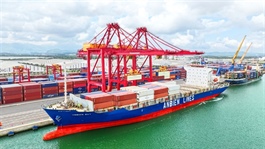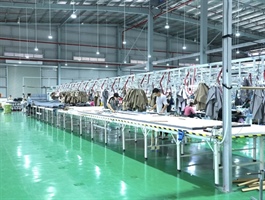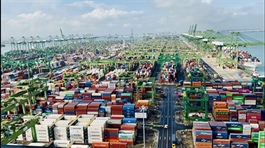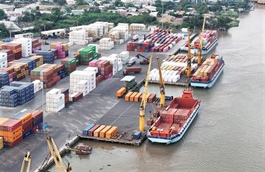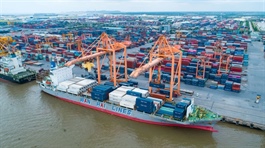Vietnam is showing resilience amid global headwinds
Vietnam is showing resilience amid global headwinds
Amid global uncertainties, Vietnam is navigating both opportunities and challenges. Nguyen Thuy Hanh, CEO of Standard Chartered Vietnam, shared her outlook with VIR’s Hong Dung.
|
How do you view the recent revisions to Vietnam’s economic growth and inflation forecasts?
We lowered our 2025 growth forecast to 6.1 per cent (from 6.7 per cent) to reflect external uncertainty in the second half of the year. We also revised down our 2025 inflation forecast to 3.5 per cent (from 3.8 per cent). Inflation’s upward reversal has stalled in recent months. However, we think demand-push factors could increase inflationary pressure in the near future. The resumption of upward inflation momentum, in addition to ongoing currency weakness, may make it challenging to lower rates. We expect the refinancing rate to stay on hold for the rest of 2025.
However, Vietnam’s economy was growing more than 6 per cent annually on average before the pandemic. Our GDP per person has potential to strengthen after dipping below the past-decade average recently. The rate of foreign investment has improved, led by the manufacturing sector and followed by the property sector. Also, Vietnam is a key link in the global supply chain and an important manufacturing hub for the region. The country is improving its position in the global supply chain thanks to integration with global trade after signing multiple free trade agreements.
We expect both external and domestic data to ease near-term and are cautiously optimistic on trade. We also cut our 2026 GDP growth and inflation forecasts to 6.2 per cent (6.7 per cent) and 3.8 per cent (5.5 per cent), respectively. Credit growth remains tentative as many businesses reduce or halt operations.
With inflation ticking up and growth holding steady, do you expect any changes to Vietnam’s current monetary policy direction?
Vietnam’s monetary policy in the second half of 2025 is expected to take a cautious and data-dependent stance, shaped by several key economic developments in June.
The second quarter GDP growth came in at 8 per cent on-year, underpinned by a robust manufacturing sector, which expanded by over 10 per cent. At the same time, exports rose 16.3 per cent on-year, with electronics leading the way, while imports jumped over 20 per cent, reflecting increased demand for industrial inputs.
However, inflationary pressure is building. Headline inflation accelerated to 3.6 per cent on-year in June, up from 3.2 per cent in May, while core inflation also edged higher to 3.5 per cent. This trend could limit the scope for further monetary easing and prompt policymakers to maintain a more neutral stance.
On the external front, Vietnam recorded a strong trade surplus of $2.8 billion in June, providing support to the currency and external balances. Meanwhile, retail sales growth softened to 8.3 per cent on-year, signalling some moderation in domestic demand.
Given these dynamics, the State Bank of Vietnam is expected to strike a balanced approach, focusing on anchoring inflation while supporting growth. The overall tone remains cautiously optimistic, with flexibility to respond should macroeconomic conditions shift in the coming months.
What policy priorities are key to sustaining Vietnam’s growth momentum and strengthen economic resilience?
There are a few measures that we can consider including accelerate public investment by speeding up infrastructure projects to entice foreign investors and boost productivity and enhancing Vietnam’s position in global supply chains through strategic trade agreements and incentives for high-value manufacturing by strengthening the manufacturing and supply chain sector. The country may also need to continue to diversify sectors to reduce concentration in the manufacturing sector and attract overseas funding over the medium term. One of the keys to sustainable growth is diversifying trade partnerships by reducing reliance on any single market and mitigate risks from geopolitical trade tensions.
Domestic consumption and services are also needed to be boosted by encouraging spending through wage growth and tax incentives. Another factor that we can support is the real estate market, for which we can implement policies to stimulate demand and stabilise the sector. Moreover, by maintaining a balanced monetary policy to control inflation while ensuring credit availability for businesses, Vietnam can maintain inflation and currency stability. By focusing on these areas, Vietnam can navigate economic headwinds and sustain strong, balanced growth in 2025 and beyond.
How is Standard Chartered Bank contributing to the advancement of local businesses, particularly small- and medium-sized enterprises (SMEs)?
Vietnam’s private sector, particularly SMEs, plays a pivotal role in the country’s economic development, and the Vietnamese government has been a strong advocate for fostering their growth. We are proud to support this vision through the launch of SC WIN (Women’s International Network), a global initiative designed to empower women entrepreneurs by addressing financial and non-financial barriers to help their businesses thrive. The launch event, held in Ho Chi Minh City in early July, marks a significant milestone in the bank’s commitment to fostering inclusive economic growth in Vietnam, particularly for women-led SMEs.
At the event, Standard Chartered Vietnam signed the partnership with Softdreams, a top digital platform that provides e-invoicing and digital enterprise management solutions for businesses. By leveraging Softdreams’s digital capabilities and Standard Chartered’s financial expertise, this partnership aims to support the working capital needs of SMEs, driving business growth and financial inclusion.
By providing SMEs, especially those led by women, with access to innovative digital lending and global networks, we are helping to build a more inclusive and sustainable future for Vietnam’s economy. Through SC WIN, Standard Chartered will invest more resources with a commitment to providing $1 billion in financing to women entrepreneurs globally by 2028, helping them to reach new heights in their businesses and contribute to the economic and social development.
|
- 18:07 25/07/2025





